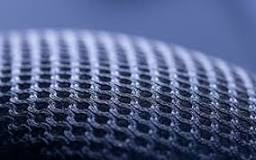SMART TEXTILES:
Smart textiles are fabrics that incorporate advanced technological components, allowing them to sense and react to external stimuli like temperature, pressure, or even biological signals, essentially “thinking” and responding accordingly, often used for performance enhancement, health monitoring, and even fashion applications by integrating functionalities like heating, cooling, or data collection directly into the fabric itself; essentially making textiles “smart” by enabling them to actively adapt to their environment or wearer’s needs.
Key points about smart textiles:
- Functionality: Smart textiles can monitor vital signs like heart rate, regulate body temperature, provide haptic feedback, or even change color based on external conditions.
- Embedded technology: These functionalities are achieved by integrating tiny electronic components like sensors, actuators, and conductors directly into the fabric fibers or by applying special coatings.
- Applications: Smart textiles are used in various fields including sports apparel, medical wearables, protective gear, military uniforms, fashion accessories, and even home textiles.
Examples of smart textile technologies:
- Shape memory fabrics: Can recover from wrinkles or deformations when exposed to heat.
- Phase change materials (PCMs): Absorb and release heat to regulate body temperature
- Conductive fibers: Allow for the flow of electricity through the fabric, enabling features like heating elements or sensors
- Biometric sensors: Monitor physiological data like heart rate, respiration, and skin temperature
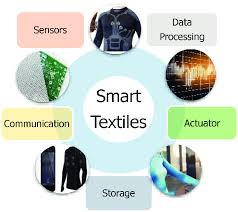
KEY FEATURES:
Smart textiles are fabrics embedded with electronic components like sensors and actuators, allowing them to respond to environmental stimuli by changing their properties, typically including features like sensing capabilities, data processing, energy supply, communication, and the ability to react to changes in temperature, pressure, or light, often used for health monitoring and adaptive clothing applications.
Key features of smart textiles:
- Sensors: Integrated sensors to detect various stimuli like temperature, pressure, humidity, movement, or physiological data (heart rate, respiration).
- Actuators: Components that respond to sensor data by triggering actions like changing shape, color, or temperature.
- Data processing: Ability to process sensor data and trigger appropriate responses.
- Energy supply: Power source to operate the embedded electronics, often through small batteries or energy harvesting mechanisms.
- Communication: Capability to transmit collected data wirelessly to external devices.
Examples of smart textile functionalities:
- Thermochromic textiles: Change color based on temperature fluctuations.
- Shape-memory textiles: Return to a pre-set shape when exposed to heat.
- Conductive textiles: Can transmit electrical signals for wearable electronics.
- Photochromic textiles: Change color when exposed to light.
- Antimicrobial textiles: Possess antibacterial properties.
- Heated textiles: Generate heat when activated, useful for cold weather clothing.
Applications of smart textiles:
- Healthcare: Monitoring vital signs, wound care, compression garments
- Sportswear: Performance tracking, muscle activity monitoring
- Fashion: Aesthetically changing colors or patterns
- Protective gear: Adapting to environmental conditions like temperature or impact
- Military applications: Camouflage, soldier health monitoring
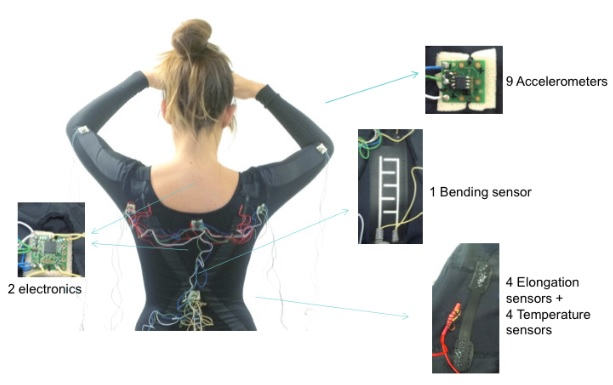
ADVANTAGES AND DISADVANTAGES OF SMART TEXTILES:
Smart textiles offer advantages like enhanced comfort and safety through features like temperature regulation, health monitoring, and responsive functionality, but they also come with disadvantages including high cost, potential durability concerns, and the need for power sources to operate the embedded electronics.
Advantages of Smart Textiles:
- Adaptive Comfort: Smart textiles can adjust to changing environmental conditions, like temperature and humidity, providing optimal comfort by cooling or heating as needed.
- Health Monitoring: Embedded sensors can monitor vital signs like heart rate, respiration, and skin temperature, enabling real-time health tracking.
- Protective Gear: Smart textiles can be used to create protective gear that responds to impact or pressure, enhancing safety in various applications.
- Performance Enhancement: Athletes can benefit from smart clothing that monitors performance metrics and provides feedback for optimization.
- Accessibility Features: Smart textiles can be integrated into clothing to provide assistance for people with disabilities, such as pressure-sensitive garments for mobility support.
- Fashion Innovation: Smart textiles open up new possibilities for design and functionality in fashion, allowing for interactive and responsive clothing.
Disadvantages of Smart Textiles:
- High Cost: Integrating electronic components into fabric is currently expensive, making smart textiles significantly more costly than traditional clothing.
- Durability Concerns: The added electronics can potentially compromise the fabric’s durability, making it susceptible to damage from washing or wear and tear.
- Power Source Requirement: Smart textiles need a power source, like batteries, which can add bulk and require frequent charging.
- Privacy Concerns: Data collected from wearable smart textiles could raise privacy concerns if not properly managed.
- Washing Limitations: Depending on the technology used, washing smart clothing might require special care or limitations.
- Technical Complexity: Designing and manufacturing complex smart textile systems can be challenging due to the need for miniaturized and integrated electronics.
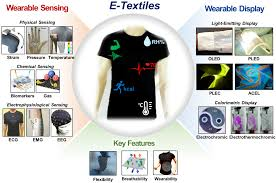
USES OF SMART TEXTILES:
Smart textiles are used for a variety of applications, primarily in healthcare to monitor vital signs like heart rate and breathing, providing personalized diagnostics by embedding biosensors into clothing that can track physiological information and flag potential health concerns; they can also be used for temperature regulation, comfort enhancement, and even in protective gear with features like color-changing capabilities depending on heat levels.
Key applications of smart textiles:
- Health monitoring: Tracking vital signs like heart rate, blood pressure, and respiration rate through integrated sensors in clothing, allowing for early detection of health issues.
- Medical applications: Wound care dressings with antimicrobial properties, drug delivery systems, and garments for post-surgical recovery.
- Performance tracking: Monitoring athlete activity levels, muscle fatigue, and movement patterns during exercise.
- Thermoregulation: Clothing that can adjust temperature based on environmental conditions or body temperature, providing comfort in varying climates.
- Protective gear: Firefighter suits that change color to reflect heat in high temperature situations.
- Accessibility aids: Smart textiles for people with disabilities, such as garments that can provide tactile feedback or assist with movement.
- Fashion applications: Integrating electronics into clothing for aesthetic purposes like color-changing features or interactive elements.
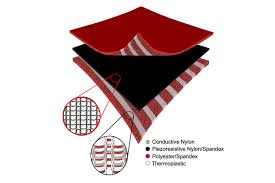
HOW IT WORKS ?
Smart textiles, also known as electronic textiles (e-textiles), work by incorporating electronic components like sensors, conductors, and microchips directly into the fabric, allowing them to monitor and respond to environmental changes or user inputs, like measuring heart rate, body temperature, or pressure, and even actively adjusting features like temperature regulation based on the data collected.
Key aspects of how smart textiles function:
- Conductive fibers: The primary element in smart textiles is conductive fibers, which are threads woven into the fabric that can conduct electricity, enabling the transmission of electrical signals.
- Sensors embedded in fabric: These sensors can be integrated into the textile to detect various parameters like body temperature, pressure, moisture, or even chemical exposure.
- Data processing unit: The collected data from the sensors is usually sent to a small processing unit embedded in the textile, which can analyze the information and trigger appropriate actions.
- Responsive mechanisms: Depending on the application, smart textiles can have built-in mechanisms that react to the collected data, such as changing color, adjusting temperature, providing haptic feedback, or sending signals to external devices.
Examples of smart textile applications:
- Athletic wear: Monitoring heart rate and activity levels during exercise
- Medical garments: Tracking vital signs like blood pressure or monitoring wound healing
- Protective clothing: Detecting hazardous environments or providing heating/cooling based on conditions
- Fashion wear: Changing color or pattern based on light exposure or temperature
Key points to remember about smart textiles:
- Material science is crucial: The development of smart textiles relies on advanced materials that can integrate electronic components while maintaining comfort and durability.
- Wash-ability and longevity: A major challenge is ensuring that the electronic components within the fabric can withstand washing and regular wear and tear.
- Integration with other technologies: Smart textiles often need to be paired with external devices like smartphones or computers to display or further analyze the collected data.
